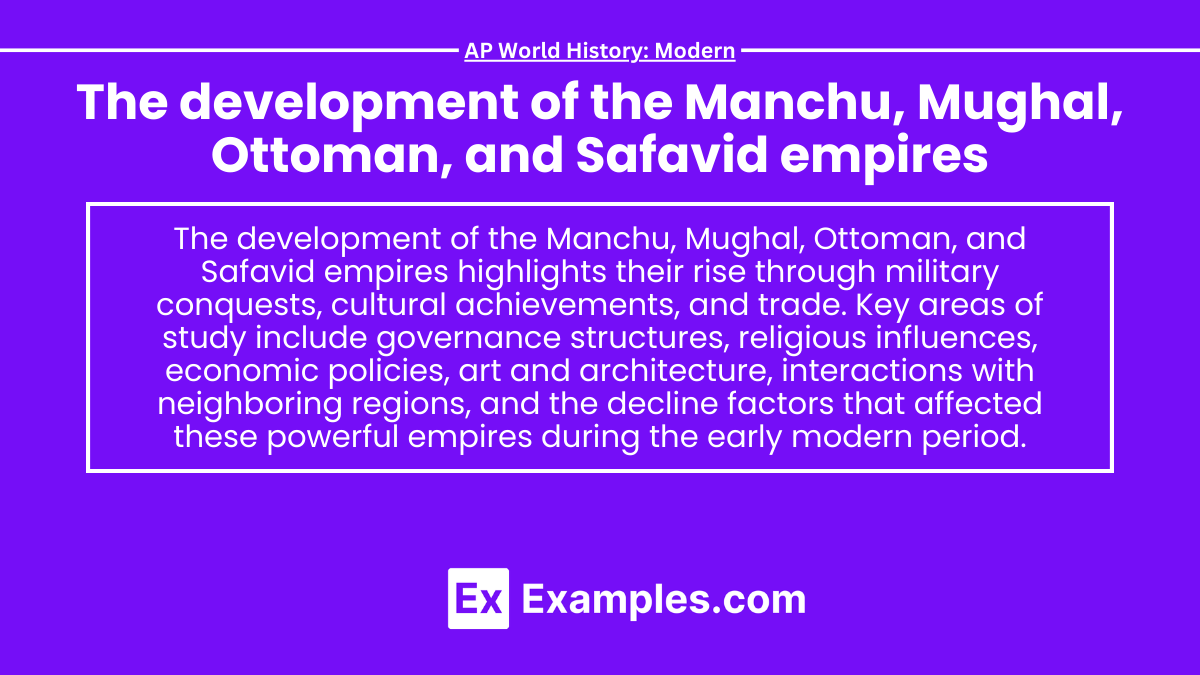The development of the Manchu, Mughal, Ottoman, and Safavid empires between the 16th and 18th centuries marked a period of vast territorial expansion, military innovation, and cultural flourishing. These empires, often referred to as “gunpowder empires,” utilized advanced weaponry to consolidate power, establish centralized administrations, and foster vibrant trade networks, leaving enduring legacies that shaped the political and cultural landscapes of their regions.
Learning Objective
In studying “The Development of the Manchu, Mughal, Ottoman, and Safavid Empires” for AP World History: Modern, you should learn to identify the key factors that contributed to the rise and expansion of these empires, including military strategies, trade networks, and cultural exchanges. Analyze the political, economic, and social structures established by each empire and evaluate their impact on regional and global dynamics. Explore the role of leadership, religion, and ethnicity in shaping imperial governance and identity. Additionally, assess the challenges these empires faced, including internal strife, external pressures, and the eventual decline, and examine their legacies in the modern world.
1. The Manchu Empire (Qing Dynasty)
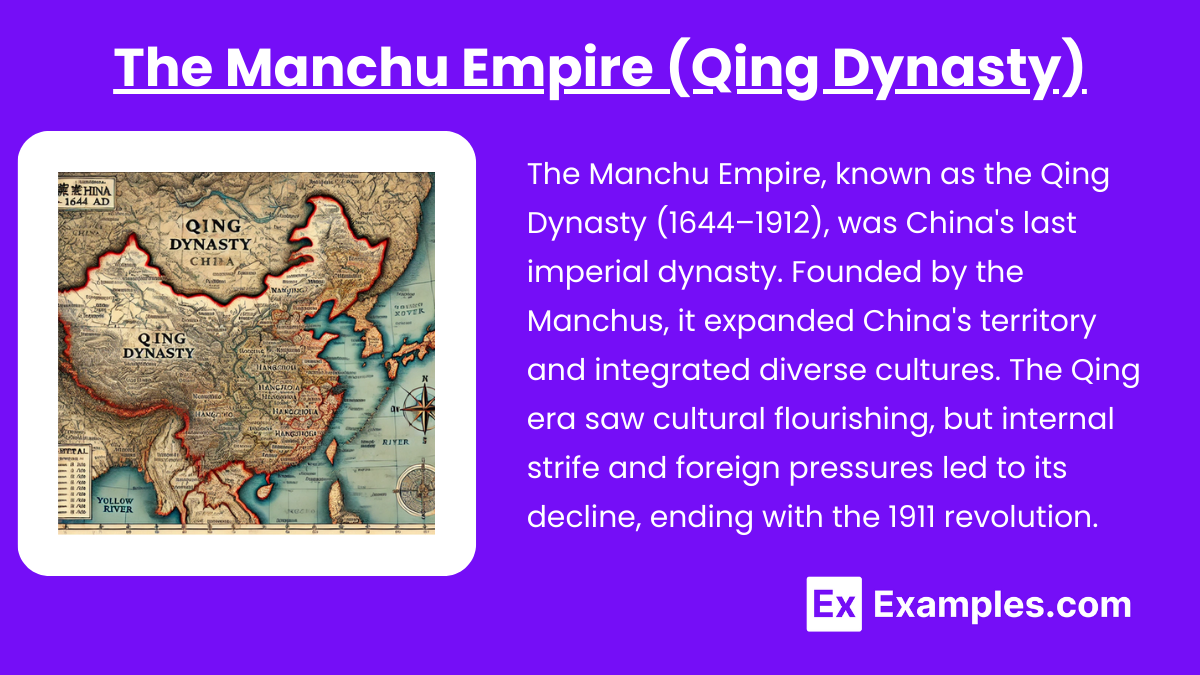
The Manchu Empire, known as the Qing Dynasty (1644–1912), was China’s last imperial dynasty. Founded by the Manchus, it expanded China’s territory and integrated diverse cultures. The Qing era saw cultural flourishing, but internal strife and foreign pressures led to its decline, ending with the 1911 revolution.
- Foundation and Expansion: The Manchu established the Qing Dynasty in 1644 after conquering the Ming Dynasty. They expanded into Central Asia, Tibet, and Mongolia, creating a vast multi-ethnic empire.
- Political Structure: The Manchu maintained a dual-administration system, retaining many Ming officials while ensuring Manchu elites occupied key positions. This ensured control while maintaining stability.
- Cultural Policies: The Qing emphasized Confucian principles, adopting and promoting Chinese traditions. The Manchu rulers, like Kangxi and Qianlong, patronized arts, literature, and scholarship, promoting the blending of Manchu and Chinese cultures.
- Trade and Economy: The Qing Dynasty became a major player in global trade, particularly with Europe. They exported silk, porcelain, and tea, and controlled key trading routes like the Silk Road.
2. The Mughal Empire
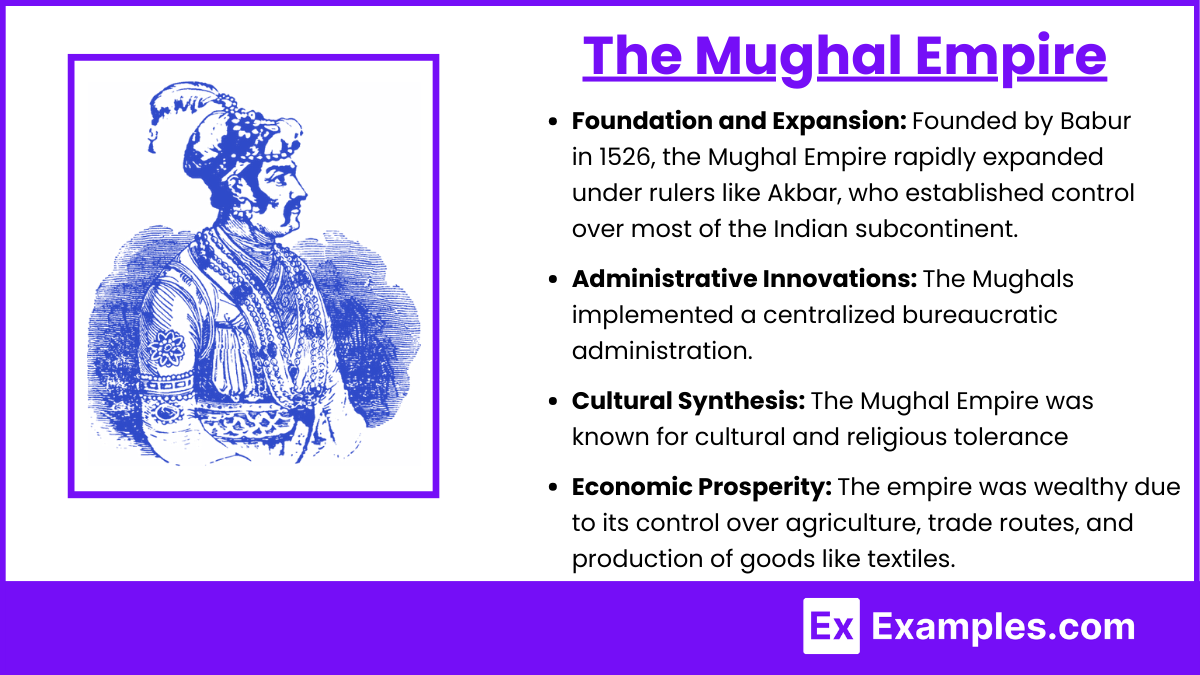
- Foundation and Expansion: Founded by Babur in 1526, the Mughal Empire rapidly expanded under rulers like Akbar, who established control over most of the Indian subcontinent. It reached its peak under Shah Jahan and Aurangzeb.
- Administrative Innovations: The Mughals implemented a centralized bureaucratic administration. Akbar’s Mansabdari system organized land and military resources efficiently, integrating a diverse population into the empire’s governance.
- Cultural Synthesis: The Mughal Empire was known for cultural and religious tolerance, particularly under Akbar, who promoted the policy of “Sulh-e-Kul” (universal tolerance). The fusion of Persian, Indian, and Islamic art and architecture flourished, evident in structures like the Taj Mahal.
- Economic Prosperity: The empire was wealthy due to its control over agriculture, trade routes, and production of goods like textiles. The empire’s cities, such as Delhi and Agra, became thriving economic centers.
3. The Ottoman Empire
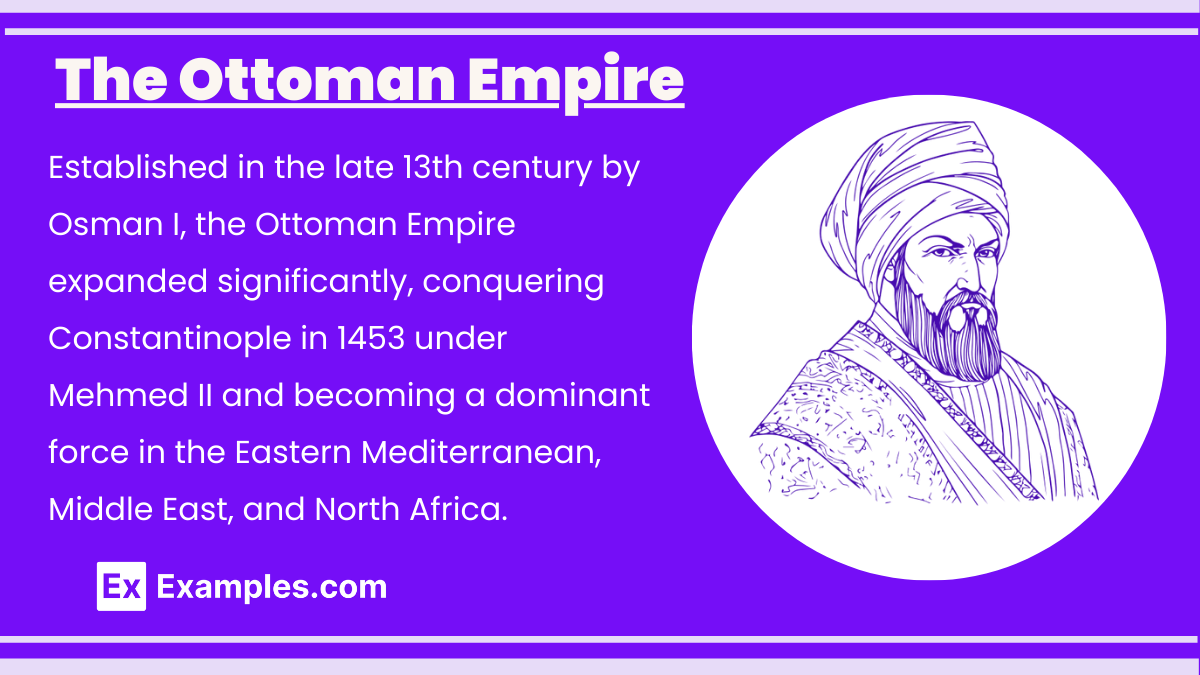
- Foundation and Expansion: Established in the late 13th century by Osman I, the Ottoman Empire expanded significantly, conquering Constantinople in 1453 under Mehmed II and becoming a dominant force in the Eastern Mediterranean, Middle East, and North Africa.
- Military Prowess: The Ottomans developed a formidable military, utilizing advanced artillery and the elite Janissary corps. The effective use of gunpowder weapons enabled the empire to conquer and defend vast territories.
- Administrative Structure: The empire was organized into a centralized administration with a sultan at the top. The Devshirme system recruited Christian boys who were converted to Islam and trained for administrative or military roles, ensuring loyalty.
- Cultural and Religious Policies: The Ottomans were Sunni Muslims and promoted Islamic laws and culture, but they allowed religious autonomy for non-Muslim communities (millets), which fostered stability in a diverse empire.
- Trade and Economy: The empire’s strategic location allowed control over key trade routes between Europe and Asia, making it a hub for commerce. It exported goods like spices, silk, and coffee, contributing to economic prosperity.
4. The Safavid Empire
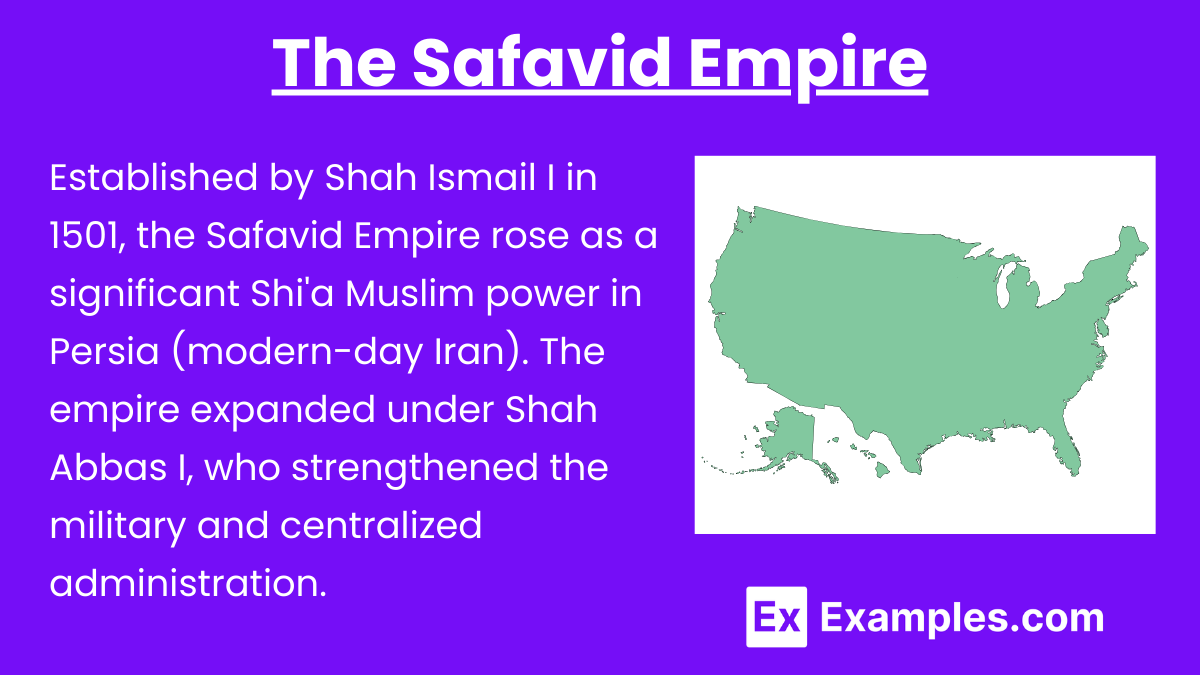
- Foundation and Expansion: Established by Shah Ismail I in 1501, the Safavid Empire rose as a significant Shi’a Muslim power in Persia (modern-day Iran). The empire expanded under Shah Abbas I, who strengthened the military and centralized administration.
- Religious Transformation: The Safavids declared Shi’a Islam as the state religion, differentiating themselves from their Sunni neighbors, the Ottomans and Mughals. This religious identity fostered a unique Persian culture.
- Military and Administrative Reforms: Shah Abbas I reformed the army, creating a standing military force composed of slave soldiers known as “ghulams.” He also reduced the power of provincial governors, strengthening central authority.
- Cultural Flourishing: The Safavid era saw significant developments in arts, architecture, and culture, blending Persian, Islamic, and Turkish influences. The capital, Isfahan, became a center of Safavid art, exemplified by the construction of the Sheikh Lotfollah Mosque.
- Economic Activities: The empire benefited from trade, producing and exporting silk, carpets, and ceramics. Safavid merchants established trade relations with European powers, contributing to economic growth.
5. Comparison and Interaction
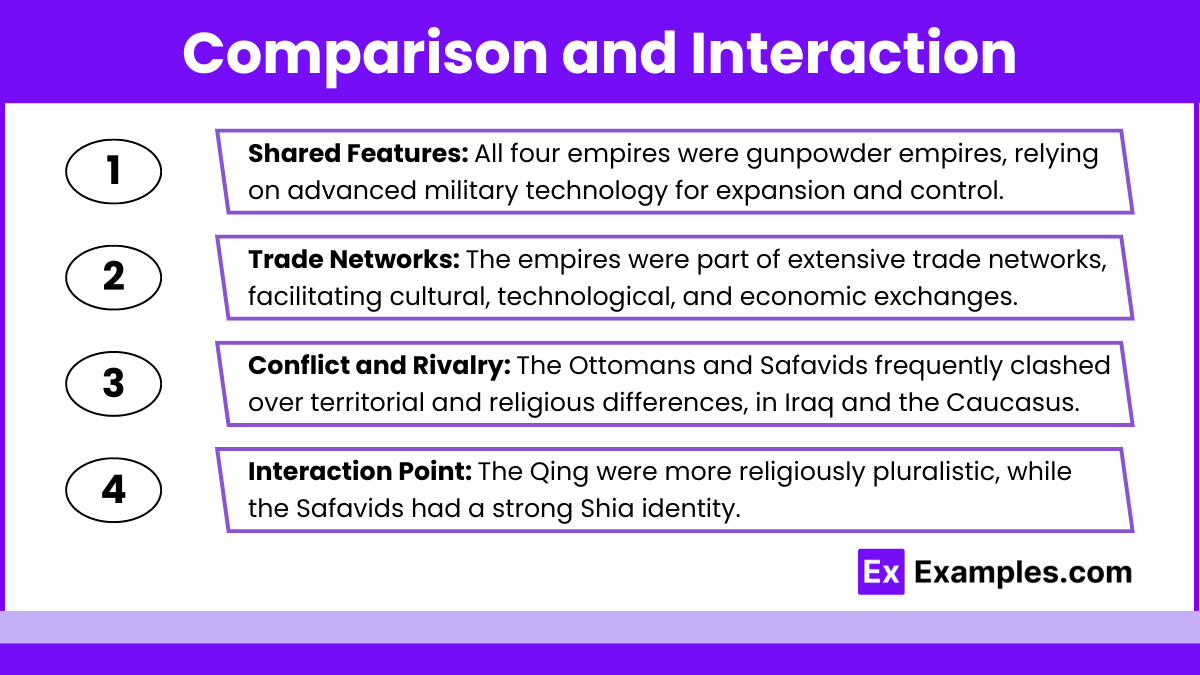
- Shared Features: All four empires were gunpowder empires, relying on advanced military technology for expansion and control. They were multi-ethnic, multi-religious states that developed complex administrative systems to manage their vast territories.
- Trade Networks: The empires were part of extensive trade networks, facilitating cultural, technological, and economic exchanges. This interaction influenced the spread of ideas, goods, and innovations across Asia, Africa, and Europe.
- Conflict and Rivalry: The Ottomans and Safavids frequently clashed over territorial and religious differences, notably in Iraq and the Caucasus. The Mughal Empire engaged in trade and occasional conflict with the Safavids, while the Qing faced challenges from expanding Russian interests in Central Asia.
- Interaction Point: The Qing were more religiously pluralistic, while the Safavids had a strong Shia identity.
Examples
Example 1: Manchu (Qing) Expansion
The Qing Dynasty expanded by conquering Tibet, Xinjiang, and Mongolia, integrating these diverse regions through military campaigns, ensuring Qing dominance across East and Central Asia.
Example 2: Mughal Administrative System
The Mughal Empire developed the Mansabdari system, a hierarchical administrative structure that integrated local elites into imperial governance, ensuring effective control over a vast and diverse population.
Example 3: Ottoman Capture of Constantinople
In 1453, the Ottomans captured Constantinople, transforming it into Istanbul, the empire’s capital. This marked the Ottomans’ rise as a dominant political and economic power in the region.
Example 4: Safavid Promotion of Shi’a Islam
The Safavid Empire established Shi’a Islam as the state religion, differentiating itself from neighboring Sunni empires, creating a unified Persian identity and consolidating political authority.
Example 5: Ottoman Devshirme System
The Ottoman Devshirme system recruited Christian boys for military and administrative roles, converting them to Islam. This created a loyal bureaucracy and strong military, contributing to empire stability.
MCQs
Question 1
Which administrative system was used by the Mughal Empire to manage its vast territories and integrate local elites into its governance?
A) Millet System
B) Mansabdari System
C) Devshirme System
D) Feudal System
Answer: B) Mansabdari System
Explanation:
The Mansabdari system organized Mughal administration, assigning ranks to officials and soldiers. It efficiently integrated diverse regional elites, ensuring loyalty and effective governance across the expansive Mughal territories.
Question 2
Which empire captured Constantinople in 1453, marking a significant turning point in its expansion and establishing it as a dominant power in the region?
A) Safavid Empire
B) Mughal Empire
C) Manchu Empire
D) Ottoman Empire
Answer: D) Ottoman Empire
Explanation:
The Ottomans captured Constantinople in 1453, transforming it into their capital, Istanbul. This victory marked their rise as a dominant political, military, and economic power in the region.
Question 3
The Safavid Empire is known for establishing which religious identity as a means of consolidating power and unifying its diverse population?
A) Sunni Islam
B) Shi’a Islam
C) Confucianism
D) Hinduism
Answer: B) Shi’a Islam
Explanation:
The Safavid Empire declared Shi’a Islam as its state religion, distinguishing itself from Sunni neighbors. This decision unified the empire under a single religious identity, strengthening political control.

